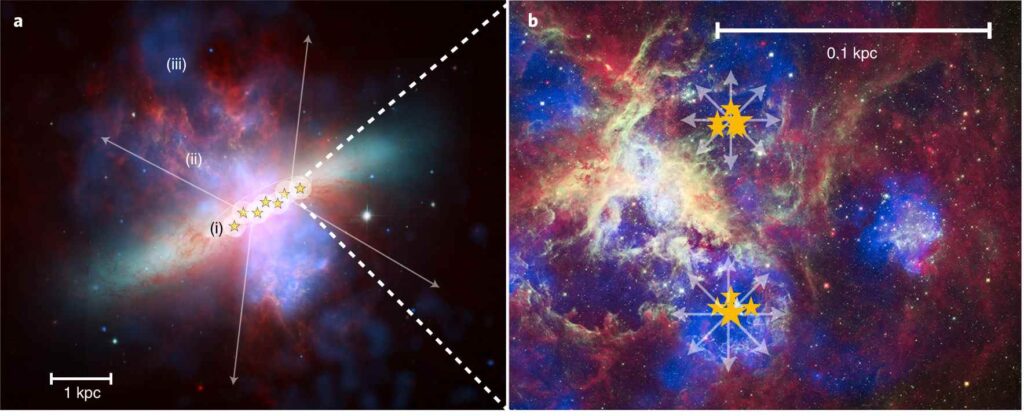Welcome to a journey into the wonders of Stars-923, an amazing supergiant star that helps us understand the universe better.
Stars-923 is an amazing supergiant star that plays an important role in our universe. It is located about 40 million light-years away in a distant spiral galaxy, and it is quite massive. Soon, it will reach the end of its life and explode in a spectacular supernova.
This article is perfect for anyone who is curious about how such huge stars impact the formation of galaxies, the life cycle of stars, and other cosmic events.
Introduction to Stars-923:
Supergiant stars, like Stars-923, are incredibly important in shaping our universe. These enormous stars not only light up the night sky but also play a key role in how galaxies grow and change over time.

They do this through processes that mix different elements and influence their surroundings. Stars-923 is a great example of a supergiant, and it presents both exciting opportunities for scientists to learn more and some tricky challenges for astronomers trying to understand it better.
The Essential Role of Supergiant Stars like Stars-923 in Creating the Elements of Life:
Supergiant stars, like Stars-923, play a crucial part in the universe’s story. These stars are incredibly large, being anywhere from 10 to 100 times bigger than our Sun. What is really important about them is how they help create the elements that make up everything around us.
As they shine, they go through a process called nuclear fusion, where they create heavier elements like carbon, oxygen, and iron.
When these massive stars reach the end of their lives, they explode in a spectacular event called a supernova. This explosion sends all those precious elements into space, which helps enrich the gas and dust that float between stars. This material is essential for forming new stars and even planets.
In fact, our own Earth exists because of the leftovers from supergiant stars that exploded long before our planet was formed.
Without the elements they produced, we would not have rocky planets or the complex chemistry needed for life. So, stars like Stars-923 are not just big and bright; they are vital for the evolution of galaxies and the very existence of life as we know it!
Read Also: Hair Botox
Stellar Feedback and Its Impact:
Supergiant stars play an important role in shaping their surroundings, a process known as stellar feedback. Basically, these massive stars, like Stars-923, release huge amounts of energy through radiation and strong stellar winds.
This energy can ionize the gas around them, creating large areas filled with charged particles. These areas can actually help spark new star formation or, in some cases, hold it back.

The powerful winds from Stars-923 also send shock waves rippling through space. These waves squeeze the gas clouds nearby, making it easier for new stars to form. However, they can also push the gas apart, which makes it harder for stars to come together.
This push-and-pull effect is what makes stellar feedback so crucial in deciding how and when new stars will form in a galaxy. It is like a cosmic dance, balancing between creating new stars and scattering the gas that would help them grow.
Facing Challenges in Observing Supergiant Stars like Stars-923:
Observing supergiant stars, such as Stars-923, comes with a bunch of challenges, mainly because they are super far away and incredibly huge. Ground-based telescopes often have a tough time because the atmosphere can make the images look blurry.
But thanks to new technology, especially adaptive optics, astronomers can fix some of these distortions on the spot, leading to clearer pictures.
Space telescopes, like the Hubble Space Telescope and the James Webb Space Telescope, are real game-changers when it comes to studying distant stars like Stars-923. Since these telescopes are above Earth’s atmosphere, they give us much sharper and more detailed views.
Plus, new techniques in spectroscopy allow scientists to learn about the chemical makeup, temperature, and speed of these giant stars, giving us important insights into their life cycles.
Even with these advances, studying Stars-923 is still tricky. It is located in a crowded part of space where interstellar dust can block our view.
This is where infrared instruments, like the James Webb Space Telescope, shine—they can see through the dust and give us better looks at these magnificent stars. It is a challenging but exciting journey to understand these giants of the universe!
Read Also: Kevin McCarthy Wife
Historical Discovery of Stars-923 – Unveiling the Mysteries of a Supergiant Star:
Stars-923 was discovered in the early 2000s during a survey that focused on massive stars in the outskirts of its galaxy. This find was exciting because Stars-923 had some really unique traits, like powerful stellar winds and an unusually high mass, which made it one of the heaviest stars known at that time.

Scientists were thrilled by this discovery because it gave them a special chance to study a supergiant star in the later stages of its life.
Moreover, finding Stars-923 sparked many questions among astronomers. They wondered how such a massive star could form and what might happen when it eventually reached the end of its life. Would it explode as a supernova? The mystery surrounding this giant star made it a hot topic in the scientific community!
The Potential Impact of a Supernova Explosion:
Stars-923, like other supergiant stars, is expected to end its life with a bang—a supernova explosion. This event would be both dramatic and life-changing for its galaxy.
When a massive star like Stars-923 goes supernova, it releases a huge amount of energy, briefly shining brighter than the entire galaxy around it.
The shock waves from this explosion would push on nearby gas clouds, sparking new star formation in some areas while disrupting it in others.
Not only would the supernova create new stars, but it would also spread elements like iron, oxygen, and silicon into space. These elements are essential for forming new stars and planets, making the surrounding environment richer for future cosmic creations.
However, this explosion could also be dangerous for any nearby planets. The intense radiation and shock waves might strip away their atmospheres or even destroy them completely. So, while a supernova can create new beginnings, it can also mean an end for some worlds.
Read Also: Https://Noticviralweb.Blogspot.Com/2024/04/Crm.Html
The Location of Stars-923 in the Universe:
Stars-923 is located in a faraway spiral galaxy about 40 million light-years from Earth. This galaxy is part of the Virgo Cluster and is filled with many supergiant stars. However, Stars-923 is special because of its huge mass and bright energy.
Its position in the galaxy’s outer areas makes it a great spot for studying how things work in the outskirts of galaxies, where new star formation happens less often compared to the inner regions.

Because Stars-923 is in a specific location within its galaxy, astronomers can learn about how supergiant stars interact with the space around them.
By watching how Stars-923’s stellar winds and bright light influence the gas and dust nearby, scientists can understand more about the bigger picture of how galaxies evolve. It is fascinating how these massive stars can play a role in shaping their environments!
Exciting Future Missions and Technologies for Studying Supergiant Stars:
Looking to the future, there are some exciting space missions and technologies on the horizon that will help us learn more about supergiant stars like Stars-923. One major development is the Extremely Large Telescope (ELT), which is expected to start operating in the late 2020s.
This telescope will have amazing resolution and sensitivity, allowing astronomers to look at distant stars with incredible detail like never before.
In addition to the ELT, there are also upcoming missions that will focus on supernovae, such as the Nancy Grace Roman Space Telescope. This will give scientists a fantastic chance to observe the dramatic explosions of stars like Stars-923.
With these advancements, astronomers will be able to explore the life cycles of supergiant stars in much greater detail. This means we will gain new insights into how these stars are born, how they change over time, and what happens to them when they eventually fade away.
The Wonder of Stars and Human Curiosity:
Stars like Stars-923 truly inspire a sense of awe and wonder in us, reminding us just how big and complicated our universe is. When we study these amazing stars, we do not just learn about cosmic events; we also find ourselves pondering deep questions about where life comes from and what it means to exist.

Supergiant stars are like cosmic time capsules, holding the history of the universe within them. By looking closely at these stars, we can better understand our place in the universe and the incredible forces that have shaped everything over billions of years. It is fascinating to think that, in a way, we are connected to these ancient giants, sharing a journey through the cosmos!
Read Also: Feli Fayer
Frequently Asked Questions (FAQs):
What is the significance of supergiant stars like Stars-923?
Supergiant stars play a key role in the chemical enrichment of galaxies, producing elements necessary for the formation of new stars and planets.
How does stellar feedback affect the surrounding environment?
Stellar feedback refers to the energy output of stars like Stars-923, which can ionize surrounding gas, drive shock waves, and trigger or inhibit star formation.
What are the challenges in observing supergiant stars?
Observing supergiant stars is difficult due to their distance and size, but advancements in space-based telescopes and adaptive optics have improved our ability to study them.
Will Stars-923 go supernova?
Yes, Stars-923 is expected to end its life in a supernova explosion, which will have a significant impact on its host galaxy.
Conclusion:
Stars like Stars-923 show just how important supergiant stars are in our universe. They play a big role in making new elements and affect how other stars are formed, making them crucial for the growth of galaxies.
Although it is tough to observe these massive stars, new technology is helping us learn more about them. Studying stars like Stars-923 not only helps us understand science better but also fills us with awe about the universe and our place in it. It is fascinating to think about how these cosmic giants shape everything around us!
Read Also:
Views-source:https://roobx4uuu.blogspot.com
Why Is The Sky Orange
